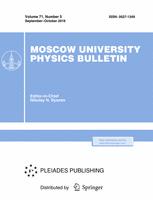The microscopic theory of specific highly excited states of the atomic nucleus - gigantic dipole resonances, is considered. Particular attention is given to the effect of different kinds of complex states on the structure of a gigantic resonance and on the photodisintegration characteristics. The process of linkages for the more complex states (both collective and noncollective in nature) leads to a condition, when a certain number of quasi-particles is added to a filled shell, sufficient for the spherical shape of the nucleus to become unstable (to a change in the properties of the surface etc.). In this case the closed shell is disturbed, which also causes an increase in the deformability of the composition of the nucleus in the highly excited state. The statistical group of states 2p2h, 3p3h etc. which ensures the statistical irreversible process of preequilibrium decay is of considerable importance in explaining the photodisintegration characteristics of atomic nuclei.
Annotation
© 2016 Publisher M.V.Lomonosov Moscow State University
Authors
F.A. Zhivopistsev and К.V. Shitikova



